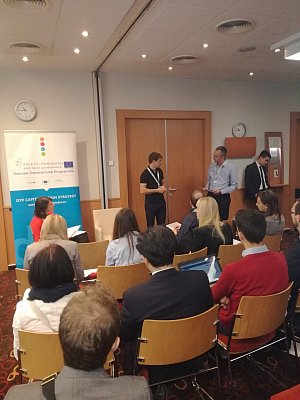WHAT ARE DTP PROJECTS RELATED TO OUR WORK DOING?
Priority Area 10 is closely following projects co-financed by the Danube Transnational Programme. There are three projects that have topics related to the topics and targets of the PA10 and we are publishing a short update on their activities and achievements.
More general information about the projects can be found at project’s websites:
AGRIGO4CITIES
Recently, two main achievements within the AgriGo4Cities project should be highlighted. Firstly, the organisation of the Transnational training session at the end of November in Munich. The most important aspects of the training were. 1) To bring the people from six pilot regions together for a first exchange about the topic of their garden project and needs in order to: a) identify their situation and needs (diagnosis phase), b) develop ideas (ideation phase), and c) develop a prototype (prototyping phase). 2) To motivate the pilot region groups to exchange their ideas on a transnational level and support each other to develop their own pilot project. 3) To involve external experts and the strategic partners to assist and steer the first prototyping. The strategic partners formed a sounding board to assist and accompany the pilot regions during the whole project. 4) To boost motivation of all participants through a relaxed, harmonious and cheerful surrounding and finally send them home with an initial action plan. Altogether, 63 people representing public administrators, vulnerable and NGOs from 9 different countries attended the 2-day session. More about the session: http://www.interreg-danube.eu/news-and-events/project-news/1376.
Secondly, Guidelines for the development and implementation of an action plan were created. The guidelines are based on good practice methodology developed in the SyCULTour projects and provide examples, tools and new canvas model developed specifically for the AgriGo4Cities project. In guidelines, reasons for urban agriculture, inclusion of marginalized social groups and participatory planning were prepared by strategic project partners. The reasons are being followed by the social innovation spiral phases (DIAGNOSIS, IDEATION, PROTOTYPE, MONITOR, SCALE, SYSTAMIC CHANGE). Each phase is presented with the short description, best practice example, longer explanation and available tools. At the end, urban agriculture canvas is presented, inspired by Social Business Model Canvas. Guidelines will lead the local partnerships in pilot areas through the key phases from initial idea to final realization of their pilot urban gardens. Link to publication: http://www.interreg-danube.eu/news-and-events/project-news/1585.
ATTRACTIVE DANUBE
Thematic part of the Attractive Danube project started with trainings for transferring the knowledge of previous Attract-See project to new project partners and to prepare them to start developing national attractiveness indicators and web based platforms for evidence based decisions regarding regional development through implementation of national workshops (NWS). Thus, Output Training for partners on developing national TAMP was completed in period 1. Participatory planning process guidance has been developed defining the participatory process, stakeholder identification, purposes of workshops and expected results. Until now all of the partners organised their first and second National Workshop, where first detailed national attractiveness indicators have been proposed and defined through a discussion with target groups.
Besides progressing on a national level, participating countries have already updated all 22 common indicators for evidence-based decisions on the transnational level to the latest available data for the Common Attractiveness Monitoring Platform-CO-TAMP which has been established (http://cotamp.gis.si/attractive_danube/). Due to proper understanding of indicators data LP GI prepared metadata template document that was fulfilled by respective project partner. LP GI also prepared an animated guidance for the use of CO-TAMP and national platforms – N-TAMP for presenting detailed indicators for monitoring and supporting development of the Danube region. Altogether 11 N-TAMP’s within participating countries are in the development process.
RARE
In the first period of the project, the focus was on the proper start-up of management, communication and thematic tasks. Internal structures and procedures were created to support the partnership in the two-and-a-half-year long implementation. Partners met twice in person to discuss the project progress and to exchange knowledge.
The thematic work has also started with the aim of creating improved evidence base of processes linked to Roma labour market involvement. Partners took steps to define key challenges institutions and public services face in boosting Roma people’s labour market activation with the objective to map procedural and institutional deficiencies. By preparing national level flowcharts, lists of institutions were created and analysed in each country in order to reveal the possible cooperation and interaction with institutions involved in Roma labour market activation. Good practices were collected and selected, and the study visits linked to them have started to better understand the local contexts and to gather the lessons learnt. The involvement of stakeholders has started by setting up local groups of actors relevant in each locality. These activities pave the way for the planning of local pilots having direct positive impact on the labour market integration of Roma people.




